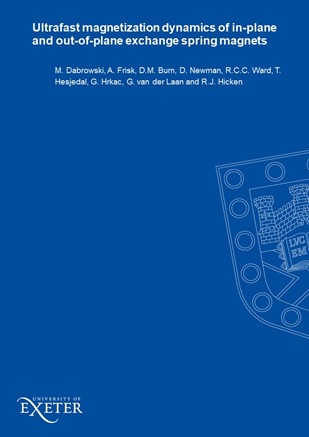
Ultrafast magnetization dynamics of in-plane and out-of-plane exchange spring magnets
M. Dabrowski, A. Frisk, D.M. Burn, D. Newman, R.C.C. Ward, T. Hesjedal, G. Hrkac, G. van der Laan and R.J. Hicken
Ultrafast Magnetism Conference York Oct 2019
Exchange Spring (ES) magnets possess a reservoir of potential energy that reduces the energy required from an external source, such as a laser pulse, to switch the magnetization direction [1]. ES structures are therefore attractive for future data storage device applications such as heat-assisted-magnetic recording (HAMR). In this work we explore the magnetization dynamics of ESs with different magnetic anisotropies and different soft/hard layer thicknesses using time-resolved magneto-optical Kerr effect (TRMOKE) measurements. We start with epitaxial Laves phase DyFe2/YFe2 structures with in-plane magnetic anisotropy, where winding and precession within the soft YFe2 layers in the [DyFe2(2nm)/YFe2(8nm)]x40 superlattice structure is demonstrated [1]. We show that the ES magnetization dynamics strongly depends upon the magnetic bias field orientation. In particular, for the magnetic field applied along the in-plane hard axis, the magnetization dynamics of the spring can be continuously excited in the field range from 0.5 T down to remanence, allowing the precession to be observed over a wide frequency range of 2.5–16 GHz. In contrast, for a DyFe2(30nm)/YFe2(7.5nm)/DyFe2(30nm) trilayer ES structure with substantially thicker hard layer and stronger in-plane magnetic anisotropy, the magnetization precession of the spring is heavily damped, with virtually no oscillations observed beyond an inflection point at around 30 ps after excitation by the fs laser pulse, regardless of the applied magnetic field direction and the pump laser fluence. Finally, we present a [Co(0.4nm)/Pt(0.9nm)]x10/Py(10nm) bilayer structure, where a 90° exchange spring between out-of-plane and in-plane magnetization orientation is formed within the Co/Pt layers. We show that for the field applied perpendicular to the sample plane the magnetization precession can be observed over a wide frequency range of 2.5–21 GHz. The precession is even present at the highest available magnetic field of 1.5 T, suggesting mutual imprinting of the spin configuration between the layers [2].
[1] L. R. Shelford, Y. Liu, U. Al-Jarah, P. A. J. de Groot, G. J. Bowden, R. C. C. Ward and R. J. Hicken, Phys. Rev. Lett. 113, 067601 (2014).
[2] M. T. Bryan, G. Heldt, T. Thomson, L. J. Heyderman and G. Hrkac, Phys. Rev. B 94, 104415 (2016).